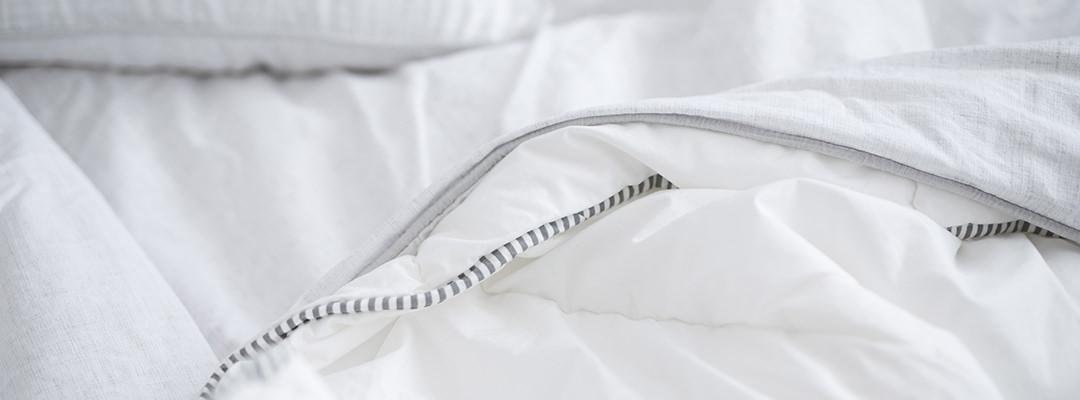You may have heard the words “duvet day” (duVET if you’re American, DUvey if you’re British) to mean a lazy, relaxing day spent luxuriating in bed. We could all use one of those once in a while, IMHO. But what is a duvet cover, exactly? And is it really the best thing for your Sunday afternoon snuggles?
Duvet covers can be a little intimidating for people who grew up with separate sheets and comforters, or who are a little embarrassed to admit that they don’t have a clue how to get the cover on (it’s cool. I was once you.). Then there’s all the terminology — duvet, duvet covers, duvet inserts, duvet sets, shell, filler, european comforter, continental quilt… cozy bedding is the last thing that should be scary, so we’re going to help you navigate some of these terms to find the duvet cover that’s right for you.
What Is a Duvet Cover?
Let’s start with a quick duvet cover definition. A duvet cover is like a pillowcase for your blanket — it goes around the outside of the duvet (the blanket part) to keep it clean. And honestly, who doesn’t want to feel like they’re sleeping under a gigantic pillow?
Duvet covers come in a huge range of materials, colours, and patterns, so there’s a perfect one for everybody. Unlike pillow cases, which are often just left open at one end, duvet covers close up so that the duvet doesn’t fall out. The cover might seal with buttons, snaps, zippers, or velcro strips.
What’s the Difference between a Duvet Cover, a Comforter, and a Throw?
Duvet
A duvet is a thick, quilted sack that’s full of soft material like down, feathers, cotton, microfibre, or silk. The outer sack is called the “shell”; the stuff on the inside is called the “filler”. This part doesn’t come undone; it will normally be sewn at regular intervals to keep the filler from moving around. Duvets are usually neutral shades like white, ivory, or grey.
Then, around it, you have your duvet cover. This is a thinner sheet that wraps around the outside of the duvet to protect it from things like spills, crumbs, and sweat. Both the duvet and the duvet cover can be washed (some duvets can be machine washed and some can only be dry cleaned — double check the label!), but with the protective duvet cover you should only need to wash the duvet very infrequently — around once a year. The duvet cover can be washed as often as you need, usually once every few weeks. Sometimes you’ll find them being sold together as a duvet set, but often you’ll need to pick them out separately.
Comforter
A comforter is another kind of blanket that’s dressier than a duvet; because it’s meant to be the top layer of your bed, you can find them in all sorts of beautiful patterns. They tend to be thinner than duvets and unlike the duvet and the duvet cover, they’re only one piece. Most people will use a separate bed sheet underneath the comforter to keep minimal contact between their skin and the comforter; however, comforters should still be washed more often than duvets. Without a separate cover, they’re more exposed to the environment. They are a little bit less fuss in the day-to-day, though — you don’t have to worry about getting them inside an enormous casing.
Throw
A throw is the lightest weight option of all. They’re usually just one or two layers of fabric and smaller than comforters and duvets. Throws are best for sitting in the garden during a cool summer evening or curling up on the sofa while watching Netflix. Then, when you’re ready to go to bed, you just… throw them across the sofa in a stylishly nonchalant kinda way. In winter, throws can be used as an extra layer of warmth over top of your other bedding blankets, but they’re not really intended to be a sleeping blanket all on their own.
Are Duvet Covers Safe?
Your bed isn’t usually the first place you’d look for health and safety concerns, but you might be interested to know that duvets are a generally safer option than comforters for two reasons.
The first is hygiene. A duvet cover is easy to wash and the duvet inside it is almost always kept sealed off from the outside world. This keeps dust, bacteria, and spilled tea from festering in your blanket. Comforters, by contrast, are a bit of a pain to keep clean and it’s easy to keep putting it off. While a bedsheet does keep you somewhat isolated from your comforter, you’d be surprised at how much your hands, arms, and face come in contact with it — especially on warmer nights, where you’re less likely to be tucked up underneath. If you do choose a comforter and sheet set, ensure that you make keeping it clean a priority.
The second reason is that, for people who toss and turn a lot in their sleep, having two separate blankets can become a bit of an obstacle course. You might find that the bed sheet becomes twisted and tangled around you during the night. Best case scenario, it’s a bit of a hassle to outmaneuver when you need to get out of bed in the morning; worst case scenario, it can begin causing problems with your circulation. A duvet and duvet cover is a thick, single piece that will stay loose while still keeping you warm.
How to Choose a Duvet Cover
Here are some questions to ask yourself when choosing the perfect cover for your duvet:
What Size Do You Need?
I cannot stress how much your heart will break once you’ve found that perfect duvet cover, only to realize it’s not available in the right size for your duvet. Double check if your duvet is a twin, double, queen, or king size. Then start by limiting your size range up front to dodge those missed connection blues.
What Material Do You Want?
Duvet covers come in a range of fabrics including cotton, linen, wool, polyester, sateen… the choices are endless. In general, synthetic materials like polyester are best for people with allergies or very sensitive skin, and natural materials like cotton or linen have better breathability. Linen is also thermoregulating, which means it adheres to your body and keeps you from getting too hot or too cold. In winter, you may want a snugglier fabric like merino wool or soft flannel to keep you cozy. If you want, you can get a couple of different fabrics and rotate them as the seasons change.
Can You Machine Wash It?
SO IMPORTANT, for everyone but especially for people with sensitive skin. If you need to dry clean or hand wash your duvet cover it’s very likely that you won’t get around to washing it as often, so dust and germs and little bits of your sour cream and onion crisps are going to start piling up — even if you can’t see it. For your personal health and your peace of mind, choose a duvet cover that can be cared for without too much fuss.
What’s Your Signature Style?
Once you’ve narrowed down the best options for your lifestyle, you get to do the fun part: picking out the perfect look. You can find duvet covers in both contemporary and vintage-inspired styles; in bold, geometric prints and soft floral patterns; delicately embroidered fabrics and proud Star Wars geekery. You may want to choose a single colour to elegantly add depth and drama to your home and sleeping space, or you may want to choose a print as proudly unique as you are.
Choosing the right duvet and duvet cover can be a bit of an investment, but you can’t put a price on an excellent night’s sleep. Duvets are warm without being suffocating, health conscious, and relatively low maintenance. They’re great for people who move around a lot when they sleep as well as people who happily settle down into eight hours of blissful hibernation.
And, as a bonus, straight from us to you, this great infographic that shows you a quick and easy way to attach your duvet cover!
Once you’ve tried sleeping with the right duvet, you’ll wonder how you ever managed with anything else.





